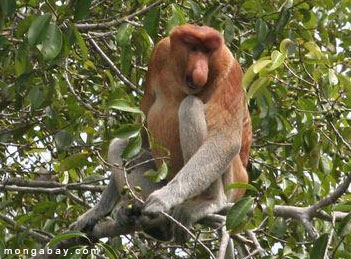Pictures of the Borneo rainforest
Rhett A. Butler, mongabay.com
March 28, 2006
Mongabay.com, a leading rainforest information web site, has launched a new section featuring photographs from the island of Borneo. More than 500 photos from Kalimantan—the Indonesian part of the island—have been added to the site.
“Borneo is one of the most biodiverse places on Earth,” says Rhett A. Butler, founder of mongabay.com, who recently traveled to the island. “Given Indonesia’s recent announcement that it plans to set aside large areas for conservation, it is important that people see what the island has to offer in terms of biological and cultural richness.”
The world’s third largest island, Borneo, is shared by three countries: Brunei Darussalam, Indonesia and Malaysia. At one time, most of Borneo was forested with tropical rainforest but today this has been greatly reduced by logging and agriculture. Presently, less than half of the island is forested and even a smaller portion can be classified as untouched, or primary forest.
Despite this forest loss, scientists believe that Borneo may house 6 percent of the world’s biodiversity. Researchers from the World Wildlife Fund (WWF) report that 361 species of animals were discovered on the island between 1994 and 2004.
 Adult male proboscis monkey in Borneo. Photo by R. Butler |
Besides pictures from Borneo, mongabay.com offers a variety of other images of wildlife and wilderness places from around the world. The site also includes news and information on environmental issues ranging from deforestation to green design to climate change.
“These pictures are just the first step,” says Butler. “In coming weeks, several articles on Borneo and rainforest conservation will be added to the site. In mid-April, mongabay.com will officially launch its revised rainforest site as well.”
Borneo Photos
Mongabay.com Articles on Borneo
Borneo rainforest protected, oil palm plantation canceled
Indonesia announced its would end plans to establish a 1.8 million hectare oil plantation in the rainforest of Borneo. The proposed plan, which was backed by Chinese investments, would have destroyed one of the most biodiverse ecosystems on Earth.
13 rare rhinos found in Borneo survey by WWF
The World Wildlife Fund released the results of a field survey from the island of Borneo which found that poaching has significantly reduced Borneo’s population of Sumatran rhinos, but a small group continues to survive in the “Heart of Borneo,” a region covered with vast tracts of rain forest..
Malaysia to phase out Borneo logging in parts of Sabah state
The Malaysian state of Sabah on the island of Borneo announced it will phase out logging in large parts of its remaining rainforests. Sabah, once home to some of the world’s most biodiverse forests, was largely logged out during the 1980s and 1990s but some parts of the state still support wild populations of endangered orangutans. In recent years, the Malaysian government has set aside protected areas and sponsored reforestation projects in the state.
Anti-HIV drug from rainforest almost lost before its discovery
Rainforest plants have long been recognized for their potential to provide healing compounds. Indigenous peoples of the rainforest have used medicinal plants for treating a wide variety of health conditions while western pharmacologists have derived a number of drugs from such plants. However, as forests around the world continue to fall — the Amazon alone has lost more than 200,000 miles of forest since the 1970s — there is a real risk that pharmaceutically-useful plants will disappear before they are examined for their chemical properties. Increasingly, it is becoming a race against time to collect and screen plants before their native habitats are destroyed. One near miss occurred recently with a compound that has shown significant anti-HIV effects, Calanolide A.